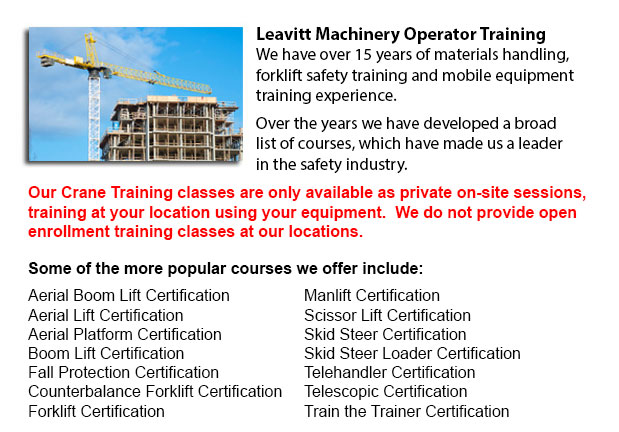
Overhead Crane Safety Training Ottawa - Overhead crane safety training equips operators with knowledge and skills regarding crane safety measures, materials handling, accident avoidance, and equipment and stock protection. Trainees will learn the types of overhead cranes, their capabilities and their uses in various industry settings. For operators who are licensed and trained, the shift in liability moves from the company to the operator. Therefore, the course emphasizes individual operator tasks.
Overhead crane safety training instructs operators in the correct methods for performing checks. Two kinds of pre-shift check are the in-depth inspection and the walk-around inspection. These are critical daily routines which must be logged. Properly recorded pre-shift inspections help to protect the company from liability in the event of an accident. Pre-shift checks also prevent accidents, damage and expensive repairs. Operators learn how to designate a specific individual to carry out inspections, how to maintain the log book and how to report problems.
Checks should be performed regularly and documented correctly. The following should inspected while watching for usual problems: hooks for cracks, increases in the throat opening, degree of twist; hoist ropes for corrosion, worn wires, loss of diameter, kinks and bird caging, broken wires, chains for nicks and gouges, chemical and heat damage, twists, cracks and corrosion, excessive wear, distortion, stretching, pits, damage caused by extreme heat.
The operator will get to learn the right ways about correct rigging measures. The process of rigging includes the understanding of the manufacturer's data plate, determining the material weight to be lifted, selecting the gear, and using safe practices to secure the load. The program include in detail the following: safe working loads, and the capacities of ropes, chains, shackles, slings and hooks.
It is essential to understand who may use the cranes at your facility, the job's physical requirements, and operator qualifications required for permits and specialized tasks. Safety is a priority when operating in the vicinity of pedestrian traffic.
The duties included in the safe crane use includes undertaking visual inspections, checking for hydraulic leaks, testing the controls, checking the safety guards, examining the hook and hoist rope, limit switches and braking mechanisms. Proper reporting methods are critical. These subject matters are all covered in depth in the course.
Right lifting and moving methods with cranes and hoists are covered in the program. Operators would become competent in hand signals. Training includes how to attach the load, raise the load, set the load, unhook the slings and abort a lift.
Moving the load involves a number of steps: starting and stopping procedures, guiding and controlling the load, working with signals and observing working conditions. Operators need to know how to proceed in case of a power failure. The course includes techniques for lowering the load and removing the slings, storage of equipment, parking the crane, and securing an outdoor and indoor crane.
-
Telehandler Ticket Ottawa
Telehandler Ticket Ottawa - The telehandler or telescopic handler is a commonly utilized equipment in industrial and agricultural applications. This machine is the same in look to a forklift and also functions in a similar manner, though telehandlers... More -
Telehandler License Ottawa
Telehandler License Ottawa - The telehandler or telescopic handler is a frequently used machine in industrial and agricultural applications. This particular equipment is the same in appearance to a forklift and even functions in a similar way, althou... More -
Forklift Training Courses Ottawa
Forklift Training Courses Ottawa - Our forklift operator safety training has been tailored for illiteracy, thus cutting the training time in half. We provide forklift training certification, lift-truck operator driver safety training evaluation, and... More -
Boom Lift Certification Ottawa
Boom Lift Certification Ottawa - Making use of elevated work platforms allow for work and maintenance operations to be carried out at elevated work heights which were otherwise unreachable. Workers using scissor lifts and boom lifts can be educated i... More -
Aerial Platform Training Ottawa
Aerial Platform Training Ottawa - Aerial lifts might be used to accomplish certain different duties done in hard to reach aerial spaces. Many of the tasks associated with this style of lift include performing routine upkeep on structures with high ce... More -
Loader Operator Certification Ottawa
Loader Operator Certification Ottawa - Ways To Acquire A Loader Operator Certification - Loader Operator Certification is normally needed for personnel working within construction, warehouse or industrial setting to ensure the safe operation of forkl... More -
Aerial Lift / Boom Lift / Man Lift / Scissor Lift Training in Ottawa
Lift tables or also referred to as scissor hoists can raise both individuals and goods vertically. They are normally utilized in commercial, industrial and construction environments. Commonly, the use of a scissor lift truck is to lift and lower thin... More -
Skid Steer Loader Training in Ottawa
The engine powered skid-steer loader comprises a small and rigid frame, equipped together with lift arms which can connect to lots of industrial attachments and tools so as to perform a wide variety of labor saving jobs. Usually, skid-steer loaders a... More

Forklift Training Ottawa
Ottawa, Ontario
forklifttrainingottawa.com
Email Us
About Us


